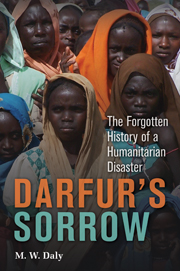Book contents
- Frontmatter
- Contents
- List of Figures
- Preface to the Second Edition
- Acknowledgments
- Chronology of Events
- Maps
- 1 The “Abode of the Blacks”
- 2 Lords of Mountain and Savanna
- 3 The Ends of the Turkish World
- 4 Darfur at the End of Time
- 5 Between an Anvil and a Hammer
- 6 “Closed District”
- 7 Unequal Struggles, 1939–1955
- 8 Colonial Legacies and Sudanese Rule, 1956–1969
- 9 Darfur and “The May Regime,” 1969–1985
- 10 Third Time Unlucky
- 11 The State of Jihad
- 12 The Destruction of Darfur
- Glossary
- Abbreviations in the Bibliography and Notes
- Notes
- Bibliography
- Index
10 - Third Time Unlucky
Darfur and the Restoration of Parliamentary Rule
Published online by Cambridge University Press: 05 August 2012
- Frontmatter
- Contents
- List of Figures
- Preface to the Second Edition
- Acknowledgments
- Chronology of Events
- Maps
- 1 The “Abode of the Blacks”
- 2 Lords of Mountain and Savanna
- 3 The Ends of the Turkish World
- 4 Darfur at the End of Time
- 5 Between an Anvil and a Hammer
- 6 “Closed District”
- 7 Unequal Struggles, 1939–1955
- 8 Colonial Legacies and Sudanese Rule, 1956–1969
- 9 Darfur and “The May Regime,” 1969–1985
- 10 Third Time Unlucky
- 11 The State of Jihad
- 12 The Destruction of Darfur
- Glossary
- Abbreviations in the Bibliography and Notes
- Notes
- Bibliography
- Index
Summary
NIMAYRIISM WITHOUT NIMAYRI
The overthrow of Jaafar Muhammad Nimayri in April 1985 bore similarities to the fall of the military regime in 1964. Within a context of economic collapse, political torpor, and civil war, demonstrations and strikes threatened general insurrection. But Nimayri's end came only when the Sudanese army, alarmed that it might share his fate, stepped in and, in a word heard frequently at the time, “hijacked” the revolution. Nimayri was en route to the Sudan from Washington when General Abd al-Rahman Muhammad Siwar al-Dahab, the army chief, announced the army's deference to “the wishes of the people.” Amid general rejoicing, Nimayri went into exile in Egypt, and a Transitional Military Council (TMC) was set up to run the country. The institutions of the May Regime were abolished or allowed to lapse: the “Permanent Constitution” of 1973 was suspended, the SSU dissolved. But the September Laws establishing Nimayri's shariʿa remained on the books (although largely unenforced), an aspect of what the Sudan People's Liberation Movement and Army (SPLM/SPLA) radio called “Nimayriism without Nimayri.”
What followed was a resumption, more smoothly than in 1965, of party politics. The very fact that every political group in the country, from the communists to the Muslim Brothers, had at one time or another collaborated with Nimayri made a general housecleaning impossible. As in 1964–65, moreover, the vanguard of “new forces,” intellectuals and professionals who had played a major role in bringing down the regime, were afterward outmaneuvered by the old-style politicians.
- Type
- Chapter
- Information
- Darfur's SorrowThe Forgotten History of a Humanitarian Disaster, pp. 234 - 246Publisher: Cambridge University PressPrint publication year: 2010

